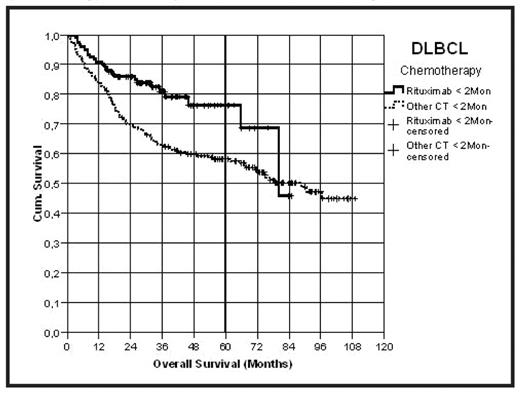Abstract
Introduction: Combination of standard chemotherapy with Rituximab led to improved disease control in pts. with B-cell lymphoma and a clearcut survival benefit in diffuse large B cell lymphoma (DLBCL) in a multitude of clinical trials. We wanted to know, if a similar benefit could be demonstrated in the routine follow-up data of the regional population-based cancer registry of the Regensburg cancer center (“Tumorzentrum Regensburg”, TUZ). The TUZ spreads evidence-based treatment recommendations, but beyond this, treatments are performed according to the discretion of individual physicians and institutions.
Methods: We searched the registry for B-NHL diagnosed between 1998 and 2005 entered as DLBCL, mantle cell lymphoma (MCL), follicular lymphoma (FL), undefined low grade lymphoma and corresponding terms from the ICD-O3. Furthermore, death certificates were systematically matched to the patient data and additionally searched for the terms C82, 83, 85, 88 of the ICD-10. Using these data, we compared overall survival of patients receiving any first line chemotherapy plus rituximab and patients receiving chemotherapy alone.
Results: Comparing registry data to death certificates an 85% coverage of lymphoma patients within the registry can be estimated. In the high grade lymphoma group, 450 patients have been entered into the registry. Of these, 49 were insufficiently documented, 29 patients had a delayed start of their treatment and 41 received no chemotherapy at all. 122 pts. received rituximab-containing chemotherapy resulting in a 2 year survival of 87%, whereas 209 pts. received chemotherapy alone with a significantly inferior 2 year survival of 70%, p=0,004 by log rank test (fig). 307 pts with low grade lymphoma were found. Of these, 31 were insufficiently documented. 84 pts. did not receive any therapy at all during the observation period and showed the best survival as expected (watch and wait). 69 and 123 pts. received first line chemotherapy with or without Rituximab, respectively. Regarding all low grade NHL together, no significant difference was found, however, FL pts. survived longer, when Rituximab was given (2 year survival 91% vs. 72%, p=0,046).
Conclusions: A survival benefit comparable to the results within clinical trials can be observed in registry data in an unsupervised community setting for patients with DLBCL treated first line with a Rituximab containing chemotherapy. A strong trend for improved survival was also observed for FL. These data confirm the standard use of Rituximab as first line therapy in DLBCL and FL and they support the collection of an extended set of treatment data containing exact descriptions of systemic therapy in cancer registries in order to answer similar questions in the future.
Disclosures: Krause:Roche: Honoraria, Travel support.
Author notes
Corresponding author


This feature is available to Subscribers Only
Sign In or Create an Account Close Modal